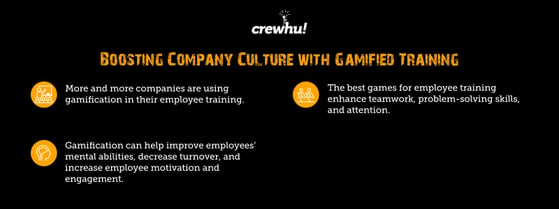Boosting Company Culture with Gamified Training


Using games for employee training has become an increasingly popular and effective method of engaging staff in their professional development. By incorporating game mechanics into the learning process, companies can enhance employee engagement, improve retention of information, and drive better results.
In this blog post, we will explore the concept of gamification in detail – its definition, benefits, and examples from the workplace. We’ll also discuss various types of games suitable for corporate training programs such as quizzes, simulations, and problem-solving exercises.
Finally, we will share best practices to help you implement a successful gamification strategy within your organization’s onboarding or training initiatives. This includes setting clear goals and objectives while keeping it fun and engaging for participants. Additionally, tracking progress and measuring results is essential to ensuring that your gamification program is having a positive impact on performance.
Gamification in employee training
Gamification strategies have proven to be highly effective in improving employee engagement, productivity, and overall job performance. By combining work duties and company goals with awards and recognition, gamification makes the learning process more fun and less stressful for employees. When properly applied, game mechanics can provide:
- Motivation: Gamified training platforms often incorporate elements such as points systems or leaderboards that encourage friendly competition among team members. These features tap into an individual’s intrinsic motivation by providing immediate feedback on their progress toward achieving specific objectives.
- Skill development: A well-designed gamification strategy allows employees to develop both hard skills (technical knowledge) and soft skills (communication abilities) simultaneously while participating in various challenges throughout the platform.
- Personalized learning: By tracking an employee’s performance within the gamified environment, trainers can identify areas where additional support or resources may be needed. This enables organizations to provide tailored learning experiences that cater to each individual's unique strengths and weaknesses.
Incorporating game mechanics into your employee training programs not only enhances engagement but also provides valuable insights into how employees are progressing toward their professional development goals. As a result, companies can make more informed decisions about allocating resources and supporting staff members in their ongoing growth.
The mental benefits
Research has shown that gaming encourages better brain connectivity, which in turn boosts productivity at work and improves hand-eye coordination. Implementing a learning tool based on gaming methodology can result in more sociable and emotionally intelligent employees, translating into lower turnover rates and higher long-term productivity.
Studies have demonstrated that gaming can improve cognitive abilities such as attention, working memory, problem-solving skills, and creativity through increased gray matter volume in regions of the brain responsible for these functions. According to a study published by the Frontiers in Human Neuroscience journal, playing video games can lead to improved brain function and increased gray matter volume within specific regions responsible for these abilities.
- Attention: Gamers tend to develop enhanced selective attention skills due to the need for constant focus while playing.
- Working Memory: Complex game scenarios require players to remember multiple pieces of information simultaneously.
- Creativity: Open-world games encourage exploration and experimentation with different strategies or solutions.
In fact, the mental benefits of gamification are so impressive that scientists are researching ways to incorporate gamification into mental health care.
The impact of gamification on employee turnover
Beyond cognitive improvements, games foster social interaction among participants who often collaborate during gameplay sessions, improving communication skills along with emotional intelligence (EI). EI is essential for building strong relationships between coworkers leading toward reduced turnover rates and increased job satisfaction.
One study found that incorporating gaming elements into onboarding led to increased engagement, motivation, and satisfaction among new hires. This not only helps employees adapt more quickly to their roles but also fosters a sense of belonging within the company culture, ultimately reducing turnover rates.
The impact on employee engagement
Incorporating game mechanics into your training program can significantly boost engagement levels by making learning more enjoyable and interactive. A well-designed gamification strategy leverages intrinsic motivators such as competition, collaboration, and achievement while helping employees master desired skills or knowledge areas.
Gamified training has been demonstrated to improve cognitive functions, leading to decreased employee attrition. By leveraging these types of games for corporate training, companies can foster innovation and creativity while also providing adaptable high-quality authoring tools that cater to diverse learners.
Best games for employee training
If you’re interested in taking advantage of all that gamification can do for your company, here are a few examples of successful gamification techniques:
Game 1: Promoting teamwork
Team-building games are an excellent way to foster collaboration and communication within your organization. One popular game for employee training is the “Marshmallow Challenge,” where teams compete against each other to build the tallest freestanding structure using marshmallows, spaghetti sticks, tape, and string. This fun activity encourages creativity while teaching valuable lessons about working together.
Game 2: Developing Problem-Solving Skills
To help develop your employees’ problem-solving skills, consider incorporating escape room-style activities. In these exercises, participants must work together under time constraints to solve puzzles or complete tasks that require critical thinking. By encouraging trial-and-error techniques in a safe environment without fear of repercussions, you can help employees learn from their mistakes and grow professionally.
Game 3: Improving attention, hand-eye coordination, and working memory
Learning games, such as those offered by platforms like BrainHQ, can significantly improve attention span, hand-eye coordination, and working memory, ultimately improving overall job performance and productivity. These games are designed to be engaging and entertaining, making it easy for employees to stay focused while simultaneously improving their cognitive skills.
Incorporating these types of gaming elements into your training program can provide an enjoyable learning experience that encourages engagement, increases retention, and develops a smarter, more productive workforce that is equipped with the necessary skills required to succeed in today’s competitive business landscape.
Conclusion
Gamification is an effective way to engage and train employees, but it’s only one part of an overall employee engagement strategy. To maximize the effectiveness of corporate training games, you also need to establish a culture that encourages recognition and appreciation. And if you need help getting started, our expert crew is just a mouse click away.
Take your employee training to the next level with Crewhu. Our platform provides MSPs with a comprehensive suite of tools for gamifying their businesses and recognizing and rewarding employees. Book a demo today and see how easy it is to boost morale and drive your business to new heights of success.
Topics: employee recognition, employee engagement, employee retention, effective management






